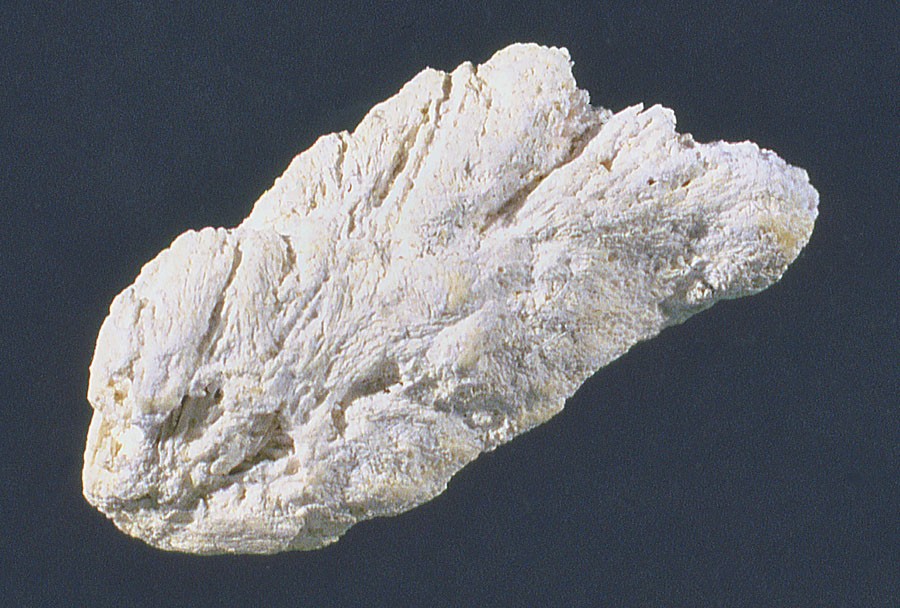Jôkokuite
A valid IMA mineral species
This page is currently not sponsored. Click here to sponsor this page.
About Jôkokuite
Formula:
MnSO4 · 5H2O
Colour:
Pale pink
Lustre:
Vitreous
Hardness:
2½
Specific Gravity:
2.03
Crystal System:
Triclinic
Member of:
Name:
Named in 1978 by M. Nambu, K. Tanida, T. Kitamura, E. Kato for the type locality of Jôkoku mine.
Unique Identifiers
Mindat ID:
2109
Long-form identifier:
mindat:1:1:2109:4
GUID
(UUID V4):
(UUID V4):
9cf29cd2-5eec-4815-8ce8-949f55d1f6e6
IMA Classification of Jôkokuite
Approved
IMA Formula:
Mn2+(SO4) · 5H2O
First published:
1978
Classification of Jôkokuite
7.CB.20
7 : SULFATES (selenates, tellurates, chromates, molybdates, wolframates)
C : Sulfates (selenates, etc.) without additional anions, with H2O
B : With only medium-sized cations
7 : SULFATES (selenates, tellurates, chromates, molybdates, wolframates)
C : Sulfates (selenates, etc.) without additional anions, with H2O
B : With only medium-sized cations
29.6.7.4
29 : HYDRATED ACID AND NORMAL SULFATES
6 : AXO4·xH2O
29 : HYDRATED ACID AND NORMAL SULFATES
6 : AXO4·xH2O
25.9.2
25 : Sulphates
9 : Sulphates of Mn
25 : Sulphates
9 : Sulphates of Mn
Mineral Symbols
As of 2021 there are now IMA–CNMNC approved mineral symbols (abbreviations) for each mineral species, useful for tables and diagrams.
| Symbol | Source | Reference |
|---|---|---|
| Jôk | IMA–CNMNC | Warr, L.N. (2021). IMA–CNMNC approved mineral symbols. Mineralogical Magazine, 85(3), 291-320. doi:10.1180/mgm.2021.43 |
Physical Properties of Jôkokuite
Vitreous
Transparency:
Transparent, Translucent
Colour:
Pale pink
Comment:
Colorless in thin section.
Streak:
White
Hardness:
2½ on Mohs scale
Cleavage:
None Observed
Density:
2.03 g/cm3 (Measured) 2.094 g/cm3 (Calculated)
Optical Data of Jôkokuite
Type:
Biaxial (-)
RI values:
nα = 1.498(3) nβ = 1.510(3) nγ = 1.517(3)
2V:
Measured: 70° to 80°, Calculated: 74°
Max Birefringence:
δ = 0.019

Image shows birefringence interference colour range (at 30µm thickness)
and does not take into account mineral colouration.
and does not take into account mineral colouration.
Surface Relief:
Low
Dispersion:
very weak
Chemistry of Jôkokuite
Mindat Formula:
MnSO4 · 5H2O
Elements listed:
Crystallography of Jôkokuite
Crystal System:
Triclinic
Class (H-M):
1 - Pinacoidal
Space Group:
P1
Cell Parameters:
a = 6.37 Å, b = 10.77 Å, c = 6.13 Å
α = 98.77°, β = 109.95°, γ = 75.03°
α = 98.77°, β = 109.95°, γ = 75.03°
Ratio:
a:b:c = 0.591 : 1 : 0.569
Unit Cell V:
380.94 ų (Calculated from Unit Cell)
Z:
2
Morphology:
Massive stalactitic, to 5 cm long.
Comment:
Space Group: by analogy to chalcanthite
X-Ray Powder Diffraction
Powder Diffraction Data:
| d-spacing | Intensity |
|---|---|
| 5.84 Å | (100) |
| 2.727 Å | (72) |
| 4.98 Å | (61) |
| 5.66 Å | (56) |
| 1.622 Å | (31) |
| 2.290 Å | (27) |
| 3.28 Å | (25) |
Geological Environment
Paragenetic Mode(s):
| Paragenetic Mode | Earliest Age (Ga) |
|---|---|
| Stage 7: Great Oxidation Event | <2.4 |
| 47a : [Near-surface hydration of prior minerals] | |
| 47b : [Sulfates and sulfites] | |
| 47e : [Vanadates, chromates, manganates] | |
| Stage 10b: Anthropogenic minerals | <10 Ka |
| 55 : Anthropogenic mine minerals |
Type Occurrence of Jôkokuite
General Appearance of Type Material:
Stalactites, up to about 5 cm long and 1 cm across, composed of irregular and fine-grained crystals with a mozaic texture. Individual grains are less than 0.05 mm across.
Place of Conservation of Type Material:
Tohoku University, Sendai; National Science Museum, Tokyo, Japan, M-21492; National Museum of Natural History, Washington, D.C., USA, 136582.
Geological Setting of Type Material:
Efflorescences in oxidized portions of mine workings.
Associated Minerals at Type Locality:
Reference:
Nambu, M., Tanida, K., Kitamura, T., Kato, E. (1978) Jôkokuite, MnSO4·5H2O, a new mineral from the Jôkoku mine, Hokkaido, Japan. Mineralogical Journal: 9: 28-38.
Synonyms of Jôkokuite
Other Language Names for Jôkokuite
Relationship of Jôkokuite to other Species
Member of:
Other Members of this group:
| Belogubite | CuZn(SO4)2 · 10H2O | Tric. 1 : P1 |
| Chalcanthite | CuSO4 · 5H2O | Tric. 1 : P1 |
| Pentahydrite | MgSO4 · 5H2O | Tric. 1 : P1 |
| Siderotil | FeSO4 · 5H2O | Tric. |
Related Minerals - Strunz-mindat Grouping
| 7.CB. | Sarvodaite | Al2(SO4)3 · 5H2O |
| 7.CB.02 | Voudourisite | CdSO4 · H2O |
| 7.CB.05 | Dwornikite | Ni(SO4) · H2O |
| 7.CB.05 | Gunningite | ZnSO4 · H2O |
| 7.CB.05 | Kieserite | MgSO4 · H2O |
| 7.CB.05 | Poitevinite | (Cu,Fe)SO4 · H2O |
| 7.CB.05 | Szmikite | MnSO4 · H2O |
| 7.CB.05 | Szomolnokite | FeSO4 · H2O |
| 7.CB.05 | Cobaltkieserite | CoSO4 · H2O |
| 7.CB.07 | Sanderite | MgSO4 · 2H2O |
| 7.CB.10 | Bonattite | CuSO4 · 3H2O |
| 7.CB.12 | Belogubite | CuZn(SO4)2 · 10H2O |
| 7.CB.15 | Aplowite | (Co,Mn,Ni)SO4 · 4H2O |
| 7.CB.15 | Boyleite | (Zn,Mg)SO4 · 4H2O |
| 7.CB.15 | Ilesite | (Mn,Zn,Fe)SO4 · 4H2O |
| 7.CB.15 | Rozenite | FeSO4 · 4H2O |
| 7.CB.15 | Starkeyite | MgSO4 · 4H2O |
| 7.CB.15 | Drobecite | CdSO4 · 4H2O |
| 7.CB.15 | Cranswickite | MgSO4 · 4H2O |
| 7.CB.20 | Chalcanthite | CuSO4 · 5H2O |
| 7.CB.20 | Pentahydrite | MgSO4 · 5H2O |
| 7.CB.20 | Siderotil | FeSO4 · 5H2O |
| 7.CB.25 | Bianchite | Zn(SO4) · 6H2O |
| 7.CB.25 | Chvaleticeite | Mn(SO4) · 6H2O |
| 7.CB.25 | Ferrohexahydrite | FeSO4 · 6H2O |
| 7.CB.25 | Hexahydrite | MgSO4 · 6H2O |
| 7.CB.25 | Moorhouseite | Co(SO4) · 6H2O |
| 7.CB.25 | Nickelhexahydrite | Ni(SO4) · 6H2O |
| 7.CB.30 | Retgersite | NiSO4 · 6H2O |
| 7.CB.35 | Bieberite | CoSO4 · 7H2O |
| 7.CB.35 | Boothite | CuSO4 · 7H2O |
| 7.CB.35 | Mallardite | MnSO4 · 7H2O |
| 7.CB.35 | Melanterite | Fe2+(H2O)6SO4 · H2O |
| 7.CB.35 | Zincmelanterite | (Zn,Cu,Fe)SO4 · 7H2O |
| 7.CB.35 | Alpersite | (Mg,Cu)(SO4) · 7H2O |
| 7.CB.40 | Epsomite | MgSO4 · 7H2O |
| 7.CB.40 | Goslarite | ZnSO4 · 7H2O |
| 7.CB.40 | Morenosite | NiSO4 · 7H2O |
| 7.CB.45 | Alunogen | Al2(SO4)3 · 17H2O |
| 7.CB.45 | Meta-alunogen | Al2(SO4)3 · 12H2O |
| 7.CB.50 | Aluminocoquimbite | Al2Fe2(SO4)6(H2O)12 · 6H2O |
| 7.CB.50 | Lazaridisite | 3CdSO4 · 8H2O |
| 7.CB.52 | Pararaisaite | CuMg[Te6+O4(OH)2] · 6H2O |
| 7.CB.55 | Coquimbite | AlFe3(SO4)6(H2O)12 · 6H2O |
| 7.CB.55 | Paracoquimbite | Fe4(SO4)6(H2O)12 · 6H2O |
| 7.CB.55 | Rhomboclase | (H5O2)Fe3+(SO4)2 · 2H2O |
| 7.CB.55 | Raisaite | CuMg[Te6+O4(OH)2] · 6H2O |
| 7.CB.57 | Caichengyunite | Fe2+3Al2(SO4)6 · 30H2O |
| 7.CB.60 | Kornelite | Fe2(SO4)3 · 7H2O |
| 7.CB.65 | Quenstedtite | Fe2(SO4)3 · 11H2O |
| 7.CB.70 | Lausenite | Fe2(SO4)3 · 5H2O |
| 7.CB.75 | Lishizhenite | ZnFe2(SO4)4 · 14H2O |
| 7.CB.75 | Römerite | Fe2+Fe3+2(SO4)4 · 14H2O |
| 7.CB.80 | Ransomite | CuFe2(SO4)4 · 6H2O |
| 7.CB.85 | Apjohnite | Mn2+Al2(SO4)4 · 22H2O |
| 7.CB.85 | Bílinite | Fe2+Fe3+2(SO4)4 · 22H2O |
| 7.CB.85 | Dietrichite | (Zn,Fe2+,Mn2+)Al2(SO4)4 · 22H2O |
| 7.CB.85 | Halotrichite | FeAl2(SO4)4 · 22H2O |
| 7.CB.85 | Pickeringite | MgAl2(SO4)4 · 22H2O |
| 7.CB.85 | Redingtonite | (Fe2+,Mg,Ni)(Cr,Al)2(SO4)4 · 22H2O |
| 7.CB.85 | Wupatkiite | (Co,Mg,Ni)Al2(SO4)4 · 22H2O |
| 7.CB.90 | Meridianiite | MgSO4 · 11H2O |
Other Information
Thermal Behaviour:
The DTA curve shows three distinctive endothermic peaks at 140°C, 328°C and 1032°C, and three weak but sharp endothermic peaks at 60°C, 83°C and 890°C.
Notes:
Readily soluble in H2O.
Special Storage/
Display Requirements:
Display Requirements:
Dehydrates to ilesite in dry air.
Health Risks:
No information on health risks for this material has been entered into the database. You should always treat mineral specimens with care.
Internet Links for Jôkokuite
mindat.org URL:
https://www.mindat.org/min-2109.html
Please feel free to link to this page.
Please feel free to link to this page.
Search Engines:
External Links:
Mineral Dealers:
References for Jôkokuite
Reference List:
Nambu, Matsuo, Tanida, Katsutoshi, Kitamura, Tsuyoshi, Kato, Eiichi (1978) Jôkokuite, MnSO4·5H2O, a new mineral from the Jôkoku Mine, Hokkaido, Japan. Mineralogical Journal, 9 (1) 28-38 doi:10.2465/minerj.9.28
Localities for Jôkokuite
Locality List
 - This locality has map coordinates listed.
- This locality has map coordinates listed.
 - This locality has estimated coordinates.
ⓘ - Click for references and further information on this occurrence.
? - Indicates mineral may be doubtful at this locality.
- This locality has estimated coordinates.
ⓘ - Click for references and further information on this occurrence.
? - Indicates mineral may be doubtful at this locality.
 - Good crystals or important locality for species.
- Good crystals or important locality for species.
 - World class for species or very significant.
(TL) - Type Locality for a valid mineral species.
(FRL) - First Recorded Locality for everything else (eg varieties).
- World class for species or very significant.
(TL) - Type Locality for a valid mineral species.
(FRL) - First Recorded Locality for everything else (eg varieties).
All localities listed without proper references should be considered as questionable.
Australia | |
| A suite of hydrated manganese sulfates ... +1 other reference |
Czech Republic | |
| Pašava +7 other references |
Japan (TL) | |
| Nambu et al. (1978) |
| Matsueda et al (1980) |
Papua New Guinea | |
| Steger (2015) |
Romania | |
| Onac (2003) |
Switzerland | |
| Ansermet (2012) |
Quick NavTopAbout JôkokuiteUnique IdentifiersIMA Classification Classification Mineral SymbolsPhysical Properties Optical Data Chemistry Crystallography X-Ray Powder DiffractionGeological EnvironmentType Occurrence SynonymsOther LanguagesRelationshipsStrunz-MindatOther InformationInternet Links References Localities Locality List



 symbol to view information about a locality.
The
symbol to view information about a locality.
The 



Johkoku mine, Kaminokuni, Hiyama District, Hiyama Subprefecture, Hokkaidō Prefecture, Japan